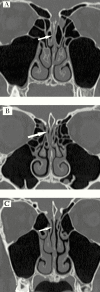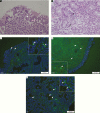Olfactory Dysfunction in Coronavirus Disease 2019 Patients: Observational Cohort Study and Systematic Review
- PMID: 32548209
- PMCID: PMC7284010
- DOI: 10.1093/ofid/ofaa199
Olfactory Dysfunction in Coronavirus Disease 2019 Patients: Observational Cohort Study and Systematic Review
Abstract
Background: Olfactory dysfunction (OD) has been reported in coronavirus disease 2019 (COVID-19). However, there are knowledge gaps about the severity, prevalence, etiology, and duration of OD in COVID-19 patients.
Methods: Olfactory function was assessed in all participants using questionnaires and the butanol threshold test (BTT). Patients with COVID-19 and abnormal olfaction were further evaluated using the smell identification test (SIT), sinus imaging, and nasoendoscopy. Selected patients received nasal biopsies. Systematic review was performed according to PRISMA guidelines. PubMed items from January 1, 2020 to April 23, 2020 were searched. Studies that reported clinical data on olfactory disturbances in COVID-19 patients were analyzed.
Results: We included 18 COVID-19 patients and 18 controls. Among COVID-19 patients, 12 of 18 (67%) reported olfactory symptoms and OD was confirmed in 6 patients by BTT and SIT. Olfactory dysfunction was the only symptom in 2 patients. Mean BTT score of patients was worse than controls (P = .004, difference in means = 1.8; 95% confidence interval, 0.6-2.9). Sinusitis and olfactory cleft obstruction were absent in most patients. Immunohistochemical analysis of nasal biopsy revealed the presence of infiltrative CD68+ macrophages harboring severe acute respiratory syndrome coronavirus 2 (SARS-CoV-2) antigen in the stroma. Olfactory dysfunction persisted in 2 patients despite clinical recovery. Systematic review showed that the prevalence of olfactory disturbances in COVID-19 ranged from 5% to 98%. Most studies did not assess olfaction quantitatively.
Conclusions: Olfactory dysfunction is common in COVID-19 and may be the only symptom. Coronavirus disease 2019-related OD can be severe and prolonged. Mucosal infiltration by CD68+ macrophages expressing SARS-CoV-2 viral antigen may contribute to COVID-19-related OD.
Keywords: COVID-19; SARS-CoV-2; anosmia; olfactory dysfunction; smell impairment.
© The Author(s) 2020. Published by Oxford University Press on behalf of Infectious Diseases Society of America.
Figures






References
-
- World Health Organization. Coronavirus disease 2019 (COVID-19) Situation Report—132 2020. Available at: https://www.who.int/docs/default-source/coronaviruse/situation-reports/2.... Accessed 01 June 2020.
LinkOut - more resources
Full Text Sources
Miscellaneous

